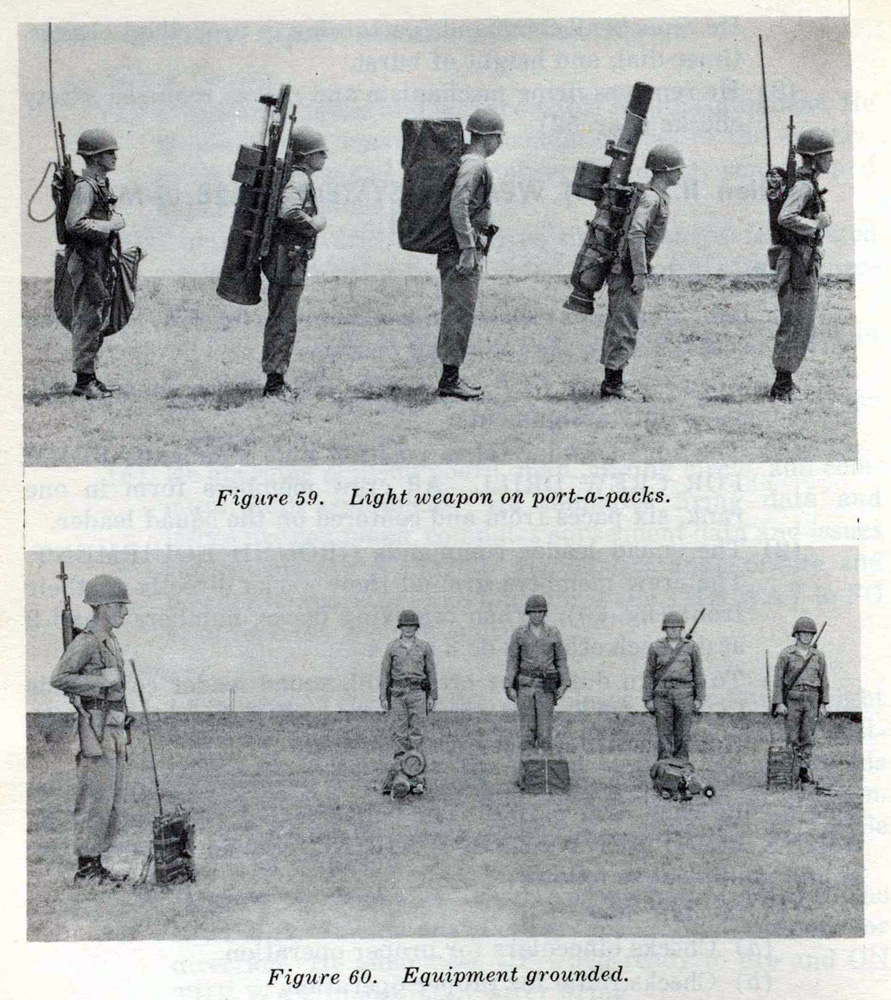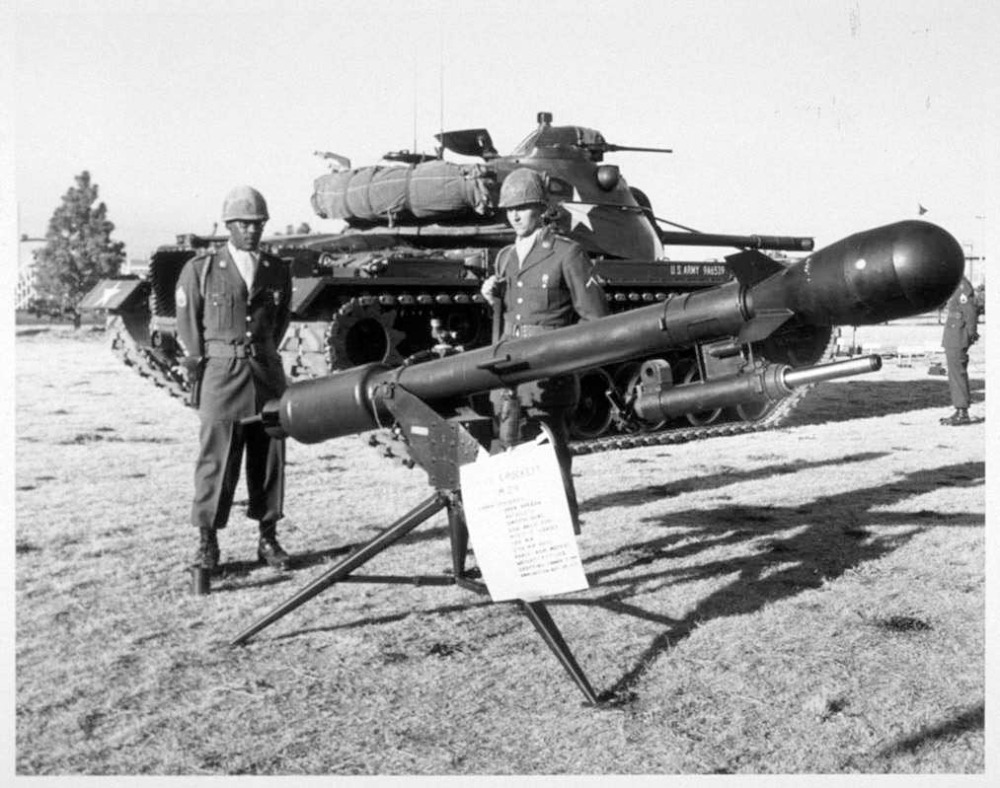You know how there are those “fun-size” candy bars that are just a bite or two that people pass out on Halloween? Well, what if there were a fun-size nuclear weapon? There was, and from 1962 to 1971 the US Army passed them out like candy. Take a look at this clearer view of the header image. The Davy Crockett nuclear launch system looks like a toy bomb stuck on the end of a pipe with a muffler from a 1950’s hot rod shop on the other end all balanced on a movie camera tripod. And that’s pretty much what it is. The launcher is a recoilless smoothbore gun that uses an explosive charge to push a rod to strike the bottom of the round and propel it forward. The weapon is recoilless because at the same time the pusher rod is launching the projectile, the muffler and tailpipe are ejecting hot gasses in the opposite direction such that the net momentum on the launcher is zero. The garage-tech aesthetic is fitting for a weapon with a heritage dating back to the improvised trench mortars and blowback pipe guns that served as short range artillery in WWI. I can already tell what you are thinking: The terms “short range” and “nuclear weapon” don’t really seem to be a good match. That’s part of why Davy Crockett only had a nine year deployment, but I’ll get to that later.
The launcher may have been primitive, but the nuclear round was the smallest nuclear device ever deployed in numbers by any nation. As I mentioned in last week’s post, making something as small a the Genie was difficult. Davy Crockett’s W-54 nuclear warhead is near the lower end of the theoretical limits of a plutonium based bomb. The W-54 weighed about 23kg and the Davy Crockett round weighed 34kg as it needed a strong shell to resist the impact of of the pusher rod and also some padding to protect its electronics package. During my research for this post I came across some sites that claim the DC had a timer based detonation system. This is not true. The round did have a timer, but that was only a safety device. Detonation was controlled by a radar altimeter. It had two settings, low and high, and would detonate the second time it came to a pre-set altitude if the timer was set at zero. Setting the timer to a few seconds would prevent the round from detonating too early if you were firing it over a hill and detonate only until after it was over the hill. And as you might imagine, there are plenty of reasons to want to fire this system from behind a hill.
So how strong was this nuclear round? Tiny, even compared to the little 1.5-2kT Genie from last week. Davy Crockett had two settings at 10 tons and 20 tons. It had a little neutron boosting tritium capsule. The capsule could pump it up to 20 tons when fully injected into the plutonium core. 10 tons TNT equivalent yield is about the same as three Oklahoma City truck bombs going off perfectly at once. Nothing to sneeze at, and perhaps the perfect weapon to ambush tanks passing through the Fulda Gap. And ambush was the plan. The entire Davy Crockett assembly could be carried to remote locations by five soldiers. I always like to describe systems in human dimensions so just think of the DC round as being able to fit into a five gallon bucket and weighing as much as four gallons of water and a medium bag of gravel. 
So there we have it. A nuclear weapons system capable of being deployed by a guerrilla force.
The Davy Crockett rounds were simply too strong for their range. The light launch system only had a range of 2km. At either blast setting that put those firing the weapon were at risk of they did not have cover. When nuclear weapons get this small, their blast-kill radius is smaller than their radiation-kill radius. With most nuclear weapons in the 1+kT range, blast rather than radiation is the primary hazard. This because the kinetic energy of the fission products heats the surrounding air up to plasma temperatures that can absorb the X-ray range black body thermal radiation. This plasma absorbs the radiation and expands and cools to create a shock wave. The Crockett rounds at either setting were too weak to create this effect and thus could kill through direct radiation those not affected by their minimal blast. The fire team needed trench cover or intervening terrain.
There was also a heavier version of the Davy Crockett that had a range of 4km. That’s safer, but notice that the soldiers in this video ducking into their trenches before the round is launched.
The Davy Crockett was withdrawn from service in 1971 because if was basically a suicide weapon. Also, it was a first use weapon, and the Nixon Administration was trying to commit to “No First Use” in the SALT I talks, so DC had to go.
As promised last week, the Davy Crocket on its tripod is just about the most phallic nuclear system ever developed. So here we go, the Atomic Wang, the Nuclear Knob, the Little Soldier at Attention: 
It just had to be a black dude modeling the heavy launcher. If you do an image search you will find plenty of people in the atomic wang position.
Reblogged this on things I've read or intend to.
LikeLike
Notice the black dude in the “wang” position is a sergeant and the other guy is a private. No one in this picture is sexually exploiting Sarge.
And as always, all pictures in Nuclear Friday are DoD or DoE issue and are property for any American citizen to use for non-commercial or even commercial purposes unless otherwise attributed.
LikeLike
First, I rarely comment but I appreciate Nuclear Friday. It’s an interesting glimpse into a past I barely remember.
Second, it seems weird that he’d stand there. He really, really wouldn’t want to be there on launch, would he? Maybe I just don’t understand the appeal since I have no wang at all. 🙂
LikeLiked by 2 people
Yes, you are correct that no soldier of any rank would want to be in the “Atomic Wang” stance if the Davy Crockett actually fired. The DC had long launching wire control. The blowback gas from the tailpipe was fairly deadly, but no more deadly than other blowback weapons of the 60’s.
Everyone was supposed to be in a trench or behind a hill.
LikeLike